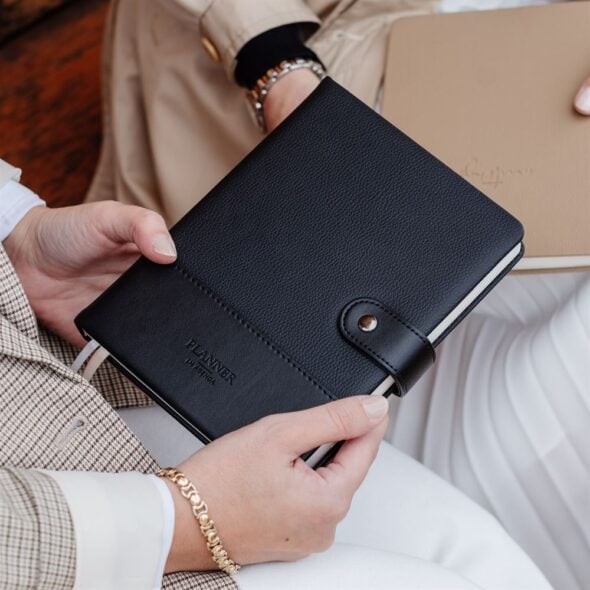The seating arrangements that you’re managing and going through on a daily basis in your company have a much bigger impact on the success or failure of events than you might imagine at first glance.
Whether it’s a business lunch, brainstorming session or employment interview, the bottom line is the same: there are rules of seating conduct that can effect drastic benefits in outcomes if followed.
Did you know our award-winning planners and journals are designed in collaboration with industry experts? They feature mindset, productivity and leadership content to inspire and empower you.
What this means for you as a success-oriented woman (or man) in the workplace is that there are both good and bad ways in which you and those you meet with can arrange yourselves in a business setting.
Luckily, reading this, and this excellent infographic that summarizes things in a more visual way, from the people at Seats & Stools, will ensure a much better chance of conducting your different business meetings well.
Here are the 4 rules of good business seating:
1. Conducting Interviews Effectively
Person-to-Person
In one-on-one interviews, the best arrangements are those which nurture easy communication and intimacy between both sides of the table, interviewee and interviewer. What this means is that the two should be seated across from each other at the narrowest part of a table, should be at equal chair height and should maintain regular eye contact.
Furthermore, if you happen to be the interviewer, offer the interviewee their seat first as a gesture of friendly courtesy.
Group Interviews
In the case of group interviews with several people interviewing one person, all of the same rules that apply to one-on-one situations should stay in effect but with the addition of group oriented protocols. These are, all interviewers should introduce themselves in order of relevance, the interviewee should afterwards introduce him or herself to the entire group and all parties should maintain well balanced eye contact while actually speaking and listening.
Discover our Make Your Mark planners and journals to help you create daily life habits to grow as a leader.
Furthermore, the table in both one-on-one meetings and group sessions should be kept free of personal belongings and other clutter.
2. Brainstorming Sessions
During brainstorming sessions, things should be kept as comfortably informal and open as possible. This is done by fostering intimacy and mutual confidence in self-expression.
Practically speaking, what this means is a focus on small groups, keeping dominant personalities separated from each other and letting no one person dominate the opinions of others by encouraging everyone to speak freely and regularly. Furthermore, a brainstorming session should avoid, when possible, the presence of executive supervisors and other high company authority figures in order to minimize employee shyness at putting forth their ideas.
Some Further Tips
- Avoid tables altogether for an even more informally comfortable setting
- Keep pomp and hierarchical protocol to a minimum for the sake of creative expressiveness, which always thrives best under informal conditions.
- Ask all participants to avoid using communication electronics during a meeting of any kind
3. Presentations
Four main presentation types exist and each has its distinct best practices
- Single Speaker Meeting
In a theater style, semicircle seating arrangement, the speaker is kept close to the audience and all of them are able to enjoy more proximity to the speaker This will facilitate better attentiveness, more communication between speaker and audience and an easier ability to be heard by all those attending. - Co-Presenter
With a co-presenter on hand, the same audience/podium setup will apply but some additional rules also apply: Both speakers should stay on stage, both speakers should have coordinated well beforehand about who speaks when and under what queues (this will avoid a lot of possible confusion), and each speaker should remain silent and avoid distracting the audience while the other is actually talking. - Panel Presentation
In the case of panel meetings, you’ll have several speakers arranged to take turns speaking before an audience. In these cases, a moderator should be on hand to keep everything organized and this moderator should remain aloof of the actual presentation while always being ready to intervene if order needs to be restored. - Sales Meetings
If you’re going to be doing a sales meeting, whether it should have a single presenter or multiple speakers, either should be arranged before a seated audience that’s comfortable, close and willing to listen. This will make them pay more attention to the sales pitch and in turn, your closing rates will go up.
4. Dealing with Business Lunches
The best seating placement for a business lunch is one in which those who attend sit close to each other, feel and intimate, comfortable setting and are sitting corner to corner from one another whenever possible instead of across the table.
This will apply to lunches with just two attendees or larger meetings with several people (though no business lunch should have more than 4 or 5 attendees in total). Furthermore, the noise level at a business lunch should be low enough for everyone to talk easily, so also choose the location (restaurant, lounge) carefully based on this.
Post and infographic supplied courtesy of Matt Zajechowski via Seat & Stools.
Featured photo credit: Grant Wickes via photopin cc





Kelly
I never knew there was “a best place to sit” in business meetings or even the best lay out to suit the situation. Great information! Thanks